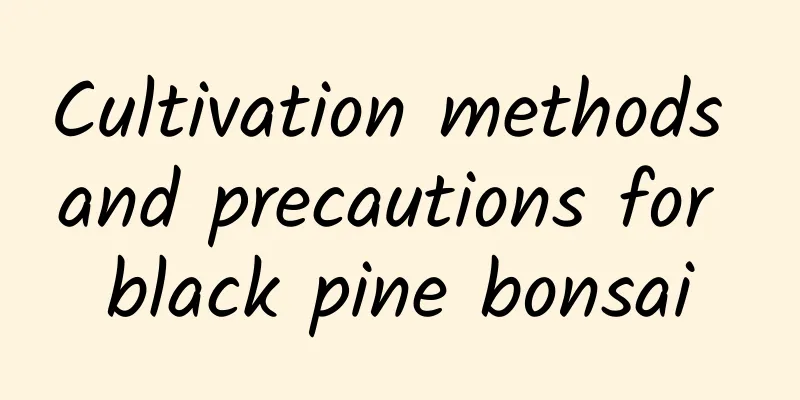Cultivation methods and precautions for black pine bonsai

|
Black pine bonsai is a kind of pine bonsai. There are many types of it, and it is widely planted in many places in my country. Black pine bonsai has tenacious vitality, strong adaptability to the environment, and a relatively high survival rate, so people are particularly fond of it, and many young people also choose to maintain it. Cultivation method of black pine bonsai1. Water appropriately Plants like black pine do not like overly moist soil. When watering, follow the principle of watering thoroughly when the soil is dry. Generally, wait until the soil in the pot is dry before watering, and be sure to water it thoroughly, but there should be no water accumulation. 2. Suitable lighting When growing black pine, it is necessary to maintain sufficient light. If there is insufficient light, branches will jump, making the shape of the entire black pine bonsai ugly. Except for the strong light in summer, it is best to receive full sunlight in spring, autumn and winter. 3. Control the temperature Black pine likes a warm environment and grows in a temperature of about 12-28 degrees. When the temperature is too high in summer, it is necessary to move the black pine to a cool and ventilated place to spend the summer. If the temperature is below zero in winter, it is best to move it indoors for the winter. 4. Reasonable fertilization In order to avoid the soil of black pine bonsai, it is best not to fertilize it at will. Generally, it is fertilized when pruning new shoots. And when fertilizing, it is necessary to pay attention to the black pine soil being dry, which is safer. For fertilizers, it is best to use nitrogen, phosphorus and potassium fertilizers as the main ingredients. Black pine bonsai maintenance precautionsYou should pay attention to the method when watering the black pine bonsai. When the weather is hot, you may need to water it once in the morning and once in the evening. When watering, you need to pay attention to try not to water it when the temperature is hottest, otherwise it will burn the roots. Reduce watering during the low temperatures in winter, and it is best to choose to water it at noon when the temperature is high. During the cultivation period of black pine bonsai, pruning should be done frequently. In winter, all the weaker and diseased branches can be pruned. In spring, buds can be removed in March and April. This will be more conducive to the growth of branches and can also adjust the direction of the bonsai branches. |
<<: When are soybeans harvested?
>>: How to prune persimmon trees to achieve the best yield
Recommend
How much is spinach per pound
1. Price The price of spinach is related to the v...
Whose cactus is it? How come it is so weird and unruly?
The super popular thornless cactus, it looks like...
How often to water a cactus
1. Watering frequency The watering time intervals...
How to propagate poplars and what to pay attention to
Poplar propagation method Poplars can be propagat...
Is it better to use a large or small pot for Molan?
Is it better to use a large or small pot for Mola...
Why is there a low fruit set rate when there are many cherry blossoms? (How can I get more fruit set when there are many blossoms)
Why do cherry flowers bloom but no fruit? It is a...
What is the difference between the leaves of yellow jasmine and white jasmine?
1. Difference of blades 1. Difference in shape: T...
Can ammonium bicarbonate be used as fertilizer? The correct way to use it
Ammonium bicarbonate is a white crystal, also kno...
How to water camphor trees in winter
Watering camphor in winter Camphor trees need to ...
How to judge the dryness and wetness of Clivia and water it (how to water it when the soil in the pot is dry on the top and wet on the bottom)
How to identify whether the pot of Clivia is dry ...
Pumpkin's growing environment and local conditions
Pumpkin growing environment and conditions Pumpki...
How to remedy the problem of rubber tree leaves turning yellow and falling off?
The rubber tree is an evergreen woody foliage pla...
The growth environment and local conditions of Achyranthes bidentata
Achyranthes bidentata growth environment and cond...
Does the rubber tree like water or drought?
Do rubber trees prefer moisture or drought? The r...
What to do if Clivia is pinched when it blooms? How to deal with the stems after flowering
1. What to do if an arrow is caught 1. Dark treat...









